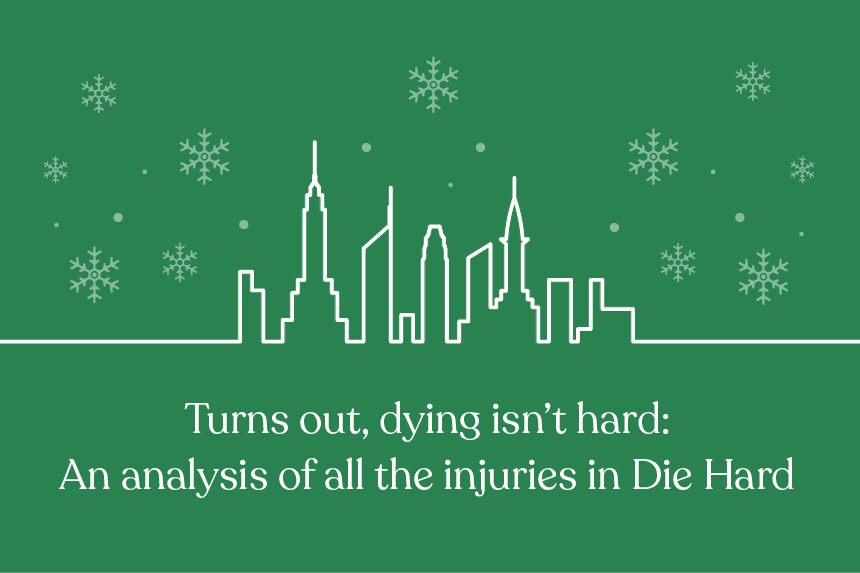Turns out, dying isn’t hard: An analysis of all the injuries in Die Hard
Dec 27th, 2023

The winter holiday season is arguably one of my favorite times of the year. Like you, I enjoy spending the holidays with family and friends, exchanging gifts, sharing love and joy, and eating special meals.
For me, however, it just doesn’t feel like the holidays until Hans Gruber falls off the Nakatomi Building. I’m talking, of course, about the movie that most embodies our American holiday traditions: Die Hard.
This 80s classic is jam-packed with action, shootouts, explosions, struggles, drama, tension, and, most importantly, the holiday spirit! Just like my family reunions on December 25.
Die Hard is one of the best action flicks ever and is just plain fun. But if you watch closely, you might notice how much bodily harm and injuries our hero John McClane (played by Hollywood legend Bruce Willis) endures as he fights the bad guys, reunites with his wife, and ultimately saves the day – and the holiday.
While the movie ends with McClane riding off into the sunset, most healthcare professionals would probably recommend he take a quick stop at a hospital first to treat his wounds. And if you remember the movie as well as I do, then you know that he shouldn’t have refused the ambulance.
Can’t remember exactly how many bumps, bruises, scrapes, cuts, and other assorted injuries are suffered by poor John McLane? Well, cozy up by the fire, get yourself some eggnog or hot chocolate, and join me as I cross-examine every injury – traumatic and otherwise – in Die Hard.
A quick summary of Die Hard
Let’s first set the scene. John McClane is a NYC cop visiting his estranged wife Holly (Bonnie Bedelia) in Los Angeles for the holidays. There’s no romantic reconciliation to be had at Holly’s office party, though, as a dozen vaguely European terrorists led by Hans Gruber (Alan Rickman) lock down the building and take the partygoers hostage.
McClane manages to split off and, over the course of the film’s two-hour runtime, single-handedly picks off the terrorists as the LAPD gets everyone to safety. McClane finds himself embroiled in many bone-crunching, blood-splattering, bullet-riddled fights. And while he may limp away thanks to movie magic, the seriousness of his injuries would put any lesser human in the ER…or worse.
Stairwell brawl
In the first major scuffle of the movie, McClane squares off against Tony, a tall blonde German armed with a machine gun. The two trade blows across a floor of Holly’s building, which is still under construction.
In the fight, McClane’s head is slammed through drywall and metal bars, which could easily result in a concussion (ICD-10 code S06.0X0A), possible skull fracture (S04.XX), and possibly even an epidural hematoma (S06.4X0A). The brawl concludes with McClane and Tony crashing through a door and tumbling down a flight of metal stairs, which proves fatal for Tony.
Falls down stairs are the second most common cause of accidental injury. According to a study published in the American Journal of Emergency Medicine, falls down stairs cause an average of 1 million injuries and an average of 12,000 deaths per year. Another study found that twice as many males as females died from stair falls.
McClane would likely need a full assessment from a doctor following this fall, as he could have suffered from multiple injuries to the skull, spine, ribs, and limbs, and possibly damage to internal organs. However, McClane walks this little tumble off with only minor bruises, likely because Tony cushioned his fall. That’s one coffin dodged.
Falling down an elevator shaft
While McClane may have survived his first encounter relatively unscathed, his plummet down an elevator shaft would certainly spell his doom.
In the film, our hero narrowly avoids detection from some terrorists by leaping down an elevator shaft. He manages to catch himself with the tips of his fingers and crawl to safety into an air duct.
Unfortunately, a normal person likely lacks the phalangeal fortitude needed to catch themselves this way and would probably suffer broken fingers (ICD-10 code S6.2.6) and then fall to their death. And from the way McClane’s groin hits the wall as he lands, a doctor might diagnose him with a testicular hematoma (S30.22XA). Ouch!
McClane, of course, has the strength to persevere, where he will next dispose of a crucial tool the terrorists need for their schemes.
Dodging an explosion
The terrorists have the Nakatomi Building rigged with explosives, which they aim to use to fake their own deaths and slip away into the night. Fortunately, a duffle bag full of those explosives and detonators has fallen into the hands of McClane, which he uses to send a message to his attackers.
The ensuing explosion rocks the building’s foundations and sends terrorists, police, and hostages scrambling to safety. McClane stops to admire the fireworks for a little bit too long, and the fireball surges upward to the only open escape point—right where McClane is standing.
Our hero dives out of the way but appears to be caught up in the flames. At this point in Die Hard, McClane is reduced to little more than a sleeveless undershirt and jeans, which offer little protection from the explosion. It’s likely he could have significant burns to his body (ICD-10 code T21.30XA) and potentially blast injuries.
Blast injuries are a complex type of physical trauma resulting from exposure to an explosion and come in three different types—all of which McClane may have experienced. A primary blast injury results from the high pressures created by explosions, which could have perforated his eardrums due to his proximity. Secondary blast injuries occur when shrapnel fragments from the explosion collide with or penetrate the body. And tertiary blast injuries result from the force of being thrown by the explosion, which could cause blunt injuries, bone fractures, or a concussion.
Explosions, of course, are a staple of action movies, and surviving one is essentially required for any hero worth their salt. So, let’s be generous and say McClane is lucky and walks away alright.
Walking across glass
In a movie full of excellent action sequences and practical effects, perhaps my favorite is when McClane must escape a shootout by running across a floor riddled with shards of glass.
This scene is a real eye-wincer as McClane crawls into a bathroom with streaks of blood trailing from his feet. Clearly, his feet have suffered some deep lacerations.
As the gunshots quiet down, McClane takes this moment of brief reprieve to administer some basic first aid and pick the glass chunks out of his feet. However, a healthcare provider would be needed to dress the wounds properly. Beyond lots of antiseptic, bandages, and stitches, McClane would need the glass removed from his feet. A provider would code that procedure as HCPCS 11042 for the glass removal and 13131 for the repair work.
Extreme bungee jumping
By the climax of the film, John McClane is bruised, battered, bleeding, and shot. Even worse, the rooftop of the Nakatomi Building is about to explode. To escape this date with the Grim Reaper, McClane jumps off the skyscraper with a fire hose as his lifeline.
In epic fashion, he avoids the blast and leaps through a glass window (feet first!) into one of the lower floors.
McClane is really riding his luck now because bungee jumping down 100 feet with something that is decidedly not a bungee cord would surely have killed you or me.
The best-case scenario: the force from this stunt could easily have fractured McClane’s spine, severed his spinal cord (ICD-10 code S14.109A), and left our hero permanently paralyzed. In reality, McClane is likely a goner.
The real killer of Die Hard
Finally, the biggest killer in Die Hard is…McClane’s terrible smoking habit. Our protagonist smokes a total of six cigarettes over the course of a single evening, though you might argue that he’s under a little bit more stress than usual and is using cigarettes as a coping mechanism.
But if we take this at face value, we could extrapolate that McClane smokes many more cigarettes during a normal day. Die Hard does take place in the 80s, after all, when smokers could light up just about anywhere.
Regardless of how much McClane smokes, the CDC states that smoking remains the leading cause of preventable disease, disability, and death in the U.S. Smoking accounts for about 1 in 10 deaths every year.
Hurt for the holidays
After getting beat up, shot in the shoulder, smashing through windows, and jumping off roofs, there’s no way McClane would be able to avoid a trip to the ER. Perhaps the several intensive procedures and months of recovery and rehabilitative care happen after the credits. By the time McClane encounters the airport terrorists in Die Hard 2, he might be dependent on a wheelchair. I would watch that movie.
Is Die Hard a holiday movie? Obviously. Is it the greatest holiday movie? Well, that’s up for debate. I’ll let your dinner table take up that one.
Want to learn more about the ICD codes that are mentioned in this blog post? Curious about the frequency of other injuries? Then sign up today for a free trial of our healthcare commercial intelligence. No fire hose required.
